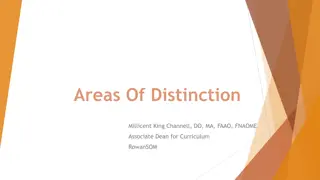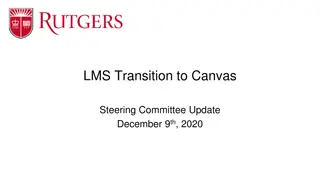Understanding Blackboard Learning Management System in Education
Blackboard training session explores the history, literature, and uses of the Blackboard learning system, shedding light on its evolution as an educational tool since 1997. From its inception at Cornell University to global adoption, Blackboard has become a versatile platform for online education, offering interactive tools and course materials accessible anytime, anywhere. The session delves into the system's configuration, benefits for instructors and students, and its role as a central hub for academic activities in various institutions.
Download Presentation

Please find below an Image/Link to download the presentation.
The content on the website is provided AS IS for your information and personal use only. It may not be sold, licensed, or shared on other websites without obtaining consent from the author. Download presentation by click this link. If you encounter any issues during the download, it is possible that the publisher has removed the file from their server.
E N D
Presentation Transcript
Blackboard training Learning Skill Course Dept. of Medical Education College of Medicine
Session-2: Blackboard training. 1. History of Blackboard (Bb) 2. Literature about Blackboard 3. Explain the content of Blackboard learning management system and it configuration 4. Enumerate the different uses of Blackboard. 5. Log on the system to explore its utilization. 6. References
History of Blackboard Founded in 1997 Founded as a powerful educational tool 1998-Released first software program at Cornell University Since then, expanding and changing software while making four more software applications
Literature about Blackboard Bb is a multimedia curriculum-driven learning system that provides instructors with control and flexibility. Worldwide educational institutions started using e-learning tools such as Bb as a part of their instructional setting. Chawdhry et al. (2011)showed that students preferred using Bb as it improves communication with the course instructor and other students. Robert et al (2004) reported that Bb adaptation by students in US (78.1%)and UK(74.3%) Abuloum et al (2006) 95% students agreed about Bb was useful in submitting homework, assignments and discussion with others , even though some technical problems.
Explain the content of Blackboard learning management system and it configuration Learning management system (LMS) is a comprehensive system to manage learning and is the central hub of the educational process on the Internet. Where courses are delivered in electronic format to all users of the system. Learning management system is easy to use and you can access it anytime and anywhere. Students can login to the system and access to the contents of the courses, and conduct academic activities. A. Discussion sessions B. Delivery responsibilities C. The performance of examinations. etc.
Different uses of Blackboard. An online learning tool used by both teachers and students Online accessible course materials through Bb can help student to study anywhere and anytime (both on and off campus). Allows students to see the course information, course material, exam dates etc. So students can retrieve it online Grades Student guide Syllabus Assignments Lectures Calendars and due dates Tests
1. Providing interactive tools for learners: An announcement: this tool enables learner to know the latest news, notifications or announcement that faculty members want to send to learners. Calendar: this tool is provided to the learner the time of events related to the subject of learning and remind him when due, time and the learner can add to it whatever he wants. Tasks: informing the learner what he has to do of tasks, it also allows him to organize them according to subject or to his personal vision. Grades: this task is for grades, whether for midterms or final exams. User manual: this tool provides list of participating students to know each other. 2. Content display: the main function of the system is to provide educational content to learners 3. Contact: the system provides three ways of communication between students and between students and the teacher as follows:- Send and receive mail messages, which provide a list of names and mailing addresses of the learners. Discussion boards: asynchronous interaction tools. Virtual classroom. 4. Follow students' progresses with the entrance to the material and held the evaluation tests. 5. Provide time to the faculty member, where he/she can create tests that can automatically correct. Also, the System can collect all grades from all resources (assignments-tests..Etc.)
Blackboard: Discussion Board A whole class can form a study group without being physically gathered in one place Students can help each other Instructor can provide help Students can be connected rather being alone and isolated when they study. Great help for online courses and regular courses
References Robert W, Bakerb JD, Hopperc D. Hybrid structures: facultyuse and perception of web-based courseware as a supplement to face-to-face instruction. Internet High Educ 2004; 7: 281e297. Robert W, Bakerb JD, Hopperc D. Hybrid structures: faculty use and perception of web-based courseware as a supplement to face-to-face instruction. Internet High Educ 2004; 7: 281e297. Webster J, Hackley P. Teaching effectiveness in technology mediated distance education.Acad Manag J 1997; 40: 1282e1309. Chawdhry A, Paullet K, Benjamin D. Assessing Bb: improving online instructional delivery. Information Systems Educators Conference, 2011. Abuloum AM, Khasawne AS. The use of blackboard as an elearning tool: a study of attitudes and technical problems. J Fac Educ 2006;(2): 1e19.























